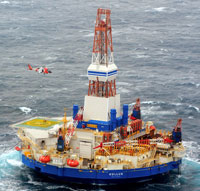
Photo: Petty Officer 1St Class Sara Francis/United States Coast Guard, via Associated Press
On Monday night, the Shell Oil drilling rig, the Kulluk, broke free from its towlines during heavy weather and ran aground on the east coast of Sitkalidak Island in the Gulf of Alaska. Sitkalidak Island is an uninhabited island separated by the Sitkalidak Strait from Kodiak Island to the west. The rig has approximately 3,600 barrels of diesel fuel, lube oil and hydraulic fluid aboard. Thus far, there are no reports of oil leaks from the grounded rig. The Kulluk is one of two rigs that Shell is using to drill test wells off the North Slope of Alaska as part of the company’s ambitious and expensive effort to open Arctic waters to oil production.
Seas are expected to be up to 33 feet by Tuesday, with the potential for 40-foot waves as a large storm system delivers moisture from as far south as California. Satellite imagery shows the bulk of the storm headed right for Kodiak.
On the Thursday, the Kulluk was being towed by the icebreaking tug Aiviq to a Seattle shipyard for off-season maintenance when the towline separated during a storm. Shortly thereafter the engines on the Aiviq failed. Leaving both the tug and the rig adrift. The 282-foot Coast Guard Cutter Alex Haley was dispatched from Kodiak to assist the Aiviq. In 35-foot seas and 40-mph winds, however, the cutter became entangled in the tow line, finally returning to Kodiak for repairs. On Sunday, the 18 personnel aboard the Kulluk were evacuated. The tug Alert, based in Prince William Sound, was also sent to assist, and on Monday the two tugs succeeded in reestablishing towlines to the drifting rig. Later on Monday, however, the Aiviq, again lost her towline. Several hours later, the tug Alert was ordered to disconnect its towline, out of concern for the safety of the ship’s nine-person crew.
Shell Oil has spent six years and more than $4 billion in its effort to drill in Arctic waters. Last summer, Shell drilled two shallow test wells in the Beaufort Sea and the Chukchi Sea but was forced to delay further drilling until this year after a containment dome designed to contain oil from a spill failed during testing.
As reported by the Alaska Despatch, “The Kulluk and its tug weren’t operating above the Arctic Circle when the problems started late last week. And the Coast Guard’s Alaska headquarters at Kodiak are located relatively nearby the grounded Kulluk, making response efforts easier than in the Arctic, where the agency has no base. That has some Alaskans wondering what would happen if similar troubles ever occur in the much more remote and hostile Arctic Ocean.
“The implications of this very troubling incident are clear — Shell and its contractors are no match for Alaska’s weather and sea conditions either during drilling operations or during transit,” said Lois Epstein, the Arctic program director for The Wilderness Society, late Monday in a statement. “Shell’s costly drilling experiment in the Arctic Ocean needs to be stopped by the federal government or by Shell itself, given the unacceptably high risks it poses to both humans and the environment.”
Coast Guard Rescues Mobile Drilling Unit Kulluk Crew
Thanks to Phil Leon and Eric Klem for contributing to this post.
